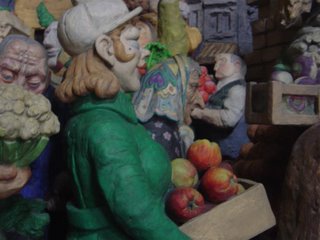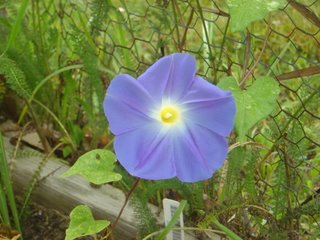
Le Departs les fruits et legumes du coeur de Paris

Pullin' weeds and pickin' stones We are made of dreams and bones Need a place to grow my own 'Cause the time is close at hand ~ David Mallet
 wholesale markets in Paris and what that meant for the life and perhaps the soul of the city.
wholesale markets in Paris and what that meant for the life and perhaps the soul of the city.
 We found a pair of chairs overlooking a lovely green spot and caught up on the events of the week and of our weeks apart. It felt so calming to be looking out over something green again.
We found a pair of chairs overlooking a lovely green spot and caught up on the events of the week and of our weeks apart. It felt so calming to be looking out over something green again. And then this morning as I did my last walk through, I spied my first morning glory getting ready to unfurl. By the time I returned with the camera, she was in full, morning, glory. I consider it the garden’s way of wishing me well on my journey. I didn’t see my first morning glory last year until August 14 … the morning of the Ag Fair. It was a good omen then, and it is a good omen now.
And then this morning as I did my last walk through, I spied my first morning glory getting ready to unfurl. By the time I returned with the camera, she was in full, morning, glory. I consider it the garden’s way of wishing me well on my journey. I didn’t see my first morning glory last year until August 14 … the morning of the Ag Fair. It was a good omen then, and it is a good omen now. It’s funny what gives you joy when you are a gardener. Right now I am getting the biggest kick out of a compost pile I built the other day. I was inspired by the directions in Charles Wilber’s How to Grow World Record Tomatoes.
It’s funny what gives you joy when you are a gardener. Right now I am getting the biggest kick out of a compost pile I built the other day. I was inspired by the directions in Charles Wilber’s How to Grow World Record Tomatoes. The heirlooms have had a hard time establishing blossoms this spring, but each plant started out with one large fruit and this is what I am presently harvesting. Then the plants went through a month of blossom drop. Only now are they establishing fruit again.
The heirlooms have had a hard time establishing blossoms this spring, but each plant started out with one large fruit and this is what I am presently harvesting. Then the plants went through a month of blossom drop. Only now are they establishing fruit again.